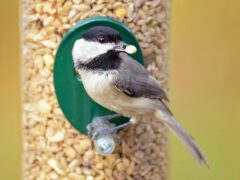American Herring Gull Photo Gallery
Breeding adult
Large gull with a somewhat large, but slim bill and robust body. Breeding adults have clean white heads and underparts with pale gray backs and wings. Note pale legs and yellow eye.
© Simon Boivin / Macaulay LibraryQuebec, July 19, 2019Nonbreeding adult
Nonbreeding adults have extensive tan streaking on their neck. Note the pale gray upperparts and the pale eye.
© G & B / Macaulay LibraryConnecticut, October 22, 2016Breeding adult
A large, barrel-chested gull with pink legs in all plumages. Breeding adult has light gray upperparts, clean white underparts, a white head, yellow eyes, a fairly slim bill with a red mark, and mostly black wingtips with some white markings.
© Greg Baker / Macaulay LibraryQuebec, August 31, 2016Not all videos have soundThird winter
Third winter birds start to acquire pale gray feathers on their back, but still have extensive tan streaking on their head and neck. Note pale yellow eye.
© Evan Lipton / Macaulay LibraryRhode Island, December 26, 2016Third winter
This more advanced third winter bird looks nearly like an adult, with its pale gray back, but it still has streaking on the neck and a black band around its bill.
© Evan Lipton / Macaulay LibraryRhode Island, December 26, 2016Breeding adult
Characteristic "long call" and display involves leaning forward, lowering the head, and giving an extended series of loud cries.
© DAVID BROWN / Macaulay LibraryMaine, July 10, 2007Not all videos have soundSecond winter
The second winter gull is heavily streaked throughout with a few gray back feathers coming in. Note dark primaries, lacking white tips.
© Chris Wood / Macaulay LibraryNew York, November 08, 2015Second winter
Some second winter birds have less streaking on their necks and look very pale overall, but note its pale eye and pink legs.
© Alex Lamoreaux / Macaulay LibraryFlorida, February 16, 2017Breeding adults
Pairs often feed each other as part of courtship. Females are usually smaller than males; this one is soliciting food from her partner using begging motions similar to those used by chicks.
© DAVID BROWN / Macaulay LibraryMaine, April 28, 2007Not all videos have soundJuvenile
Juveniles are tan overall with tan-and-white checker boarding on their back. Juveniles have an entirely dark bill and a dark eye.
© Evan Lipton / Macaulay LibraryMassachusetts, August 06, 2014Breeding adult
In flight, they look barrel-chested and broad-winged. Pale gray above with dark wingtips with only small white spots (aka "mirrors") on the dark tips.
© Jeremiah Trimble / Macaulay LibraryMaine, May 29, 2017Breeding adult and juvenile
Juveniles are brown with black bills. This one begs and receives regurgitated food from a parent, as the other parent moves in and also eats the food. Afterward, the two adults perform "long calls."
© DAVID BROWN / Macaulay LibraryMaine, August 08, 2007Not all videos have soundJuvenile
Juveniles in flight have dark primaries without the white spots or mirrors and a thick dark band across their tail.
© Louis Bevier / Macaulay LibraryMaine, August 02, 2017Habitat
Found along both coasts and near large reservoirs, lakes, and major rivers. They feed in habitats as diverse as open water, mudflats, plowed fields, and garbage dumps, and gather in almost any open space near food.
© Jay McGowan / Macaulay LibraryNew York, July 15, 2017Compare with Similar Species
Click on an image to compare
Species in This Family
Gulls, Terns, and Skimmers(Order: Charadriiformes, Family: Laridae)
Don't miss a thing! Join our email list
The Cornell Lab will send you updates about birds,
birding, and opportunities to help bird conservation.









































